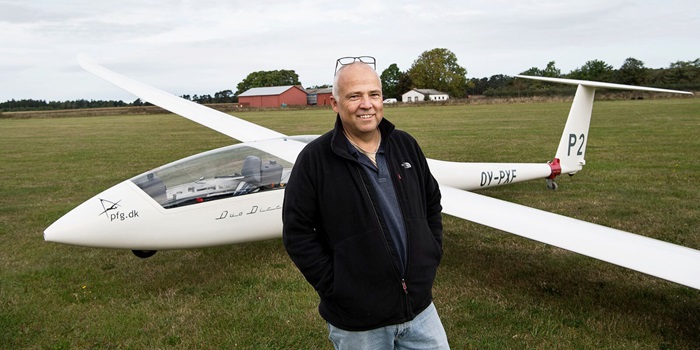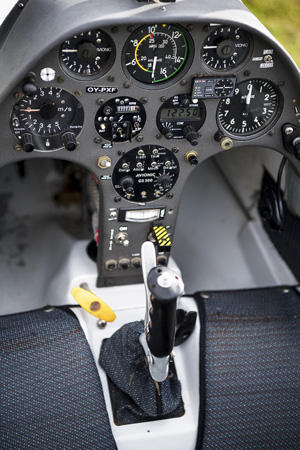An unremarkable yellow brick building stands at the end of a gravel track. A small sign bearing the text Polyteknisk Flyvegruppe (Polytechnic Flying Group) reveals that the humble domicile is ‘home’ to a group of passionate engineers who spend every weekend of the summer months watching weather forecasts, assembling aircraft, gliding around above West Zealand and eating meals prepared on the king-size barbecue in the courtyard.
It is just past 9.16 a.m. when your intrepid DTUavisen reporter rolls up at the anonymous rural property. The morning briefing on this Saturday in the middle of September has assembled about ten people, who are busily engaged in studying weather maps. They are all graduate engineers.
“It won’t be great weather for flying today, but we may get some sun this afternoon,” one of them opines.
Without sun, they won’t be taking to the skies. The sun warms the Earth, creating thermals—and without thermals, there is no reason to head over to the hangar and trundle out the handful of gliders that were otherwise scheduled to take flight today.
“You can’t just nip out for a couple of hours’ flying. Can’t do it. You need people to take care of this, that and the other on the ground, because you cannot launch a glider without help.”
So says Morten Bennick, today’s flight commander.
Having logged appreciably more than 2,000 hours behind the joystick, and with a total of three decades as a gliding enthusiast, he is an experienced glider. In the same way as many of the other club members, he has had an unswerving interest in gliding since he first felt the rush of flying through the air in a motor-less aircraft.
“For everyone who is bitten by this sport, it’s a lifetime passion. Stig Øye—who’s here today, of course—has been World Champion, and he joined Polyteknisk Flyvegruppe back in 1968. He still turns up every chance he gets,” adds Morten.
It becomes an obsession
The newest member of the club present today is Jon Steensen, who has been a member for eight years. Like many others, he joined while he was studying at DTU, and has kept on coming back. As he sees it, being a member is not just about the flying, it also has to do with the extraordinary team spirit that reigns in the clubhouse in Kladred.
“I love the flying, but the camaraderie in the club is the reason why I enjoy spending whole weekends here. I was unemployed for a while, and it meant a great deal to me that I could come up here and spend some time with a group of like-minded friends,” he says.
Many people feel the same way. Polyteknisk Flyvegruppe is more than ‘just’ a sports club, it’s a way of life. On the long summer days, the members often fly until late in the evening, and it has almost become a ritual to round off the days with steaks or other food from the barbecue, washed down with a single glass of wine.

Morten Bennick. Photo: Joachim Rode.
All the way to Jutland and back
I take part in the first flight of the day, piloted by Morten Bennick.
Launching a 450 kg glider into the air demands a really hard pull on a rope or wire. It’s actually sort of the same principle as when you’re flying a kite—but in this case the kite has been replaced by a carbon fibre aircraft, and your arm by an old engine from an American muscle car that generates three-figure horsepower.
The wire pulls taut and the little aircraft races from zero to 100 km/h in about three seconds. This causes a butterfly or two in the tummy, and if you love high speeds and crazy roller-coasters, gliding may be the sport for you. Morten is a skilled pilot, and we soon climb to an altitude of 800 metres. Kaldred is located on the coast at Saltbæk Vig (cove), with a view of Kalundborg, and the scenery is truly magnificent this sunny autumn day.
After about an hour in the air, we start to manoeuvre gently down towards the landing strip in Kaldred once more, where Morten settles the aircraft on the ground with great precision. My day at the club is drawing to a close, but there are still a few fibreglass birds circling the sky above Kaldred. On a good day, a skilled pilot can make it all the way to Jutland and back again—without landing.
I get back in my car. I have a 90-minute drive to Copenhagen. The Polyteknik pilots will hang out at their country hideaway until Sunday evening, as they so often do. It’s not just about flying; it has as much to do with the fellowship among the 70 members of Polyteknisk Flyvegruppe.
 |
|
Do you end up with bruises?
Only if you are extraordinarily unlucky. There has not been an accident at the club since 1982.
Do you need to be physically fit?
Not especially. However, you will have to do a fair bit of walking as the landing strip is a good distance from the clubhouse.
Will you meet people of the opposite sex?
There are a handful of women among the club’s 70 or so members, so this isn’t the best place to come if you’re looking for a date.
What’s the average age?
Difficult to say. More than half the club members are DTU alumni, so it’s not exactly a youth club. On the other hand, this does mean there’s always decent wine and tasty steaks for the barbecue—for members on student grants, too.
Does it require special equipment?
Not to start with. The most dedicated members have their own gliders, and it can soon turn expensive—but you don’t need your own aircraft to start with. A sunhat, practical clothes and sunglasses, and you’re good to go.
Where does it hurt the next day?
Your legs might be a little sore, because you do a lot of walking. You might notice it in your bum, too, because the seats in a glider aren’t overly spacious.
|